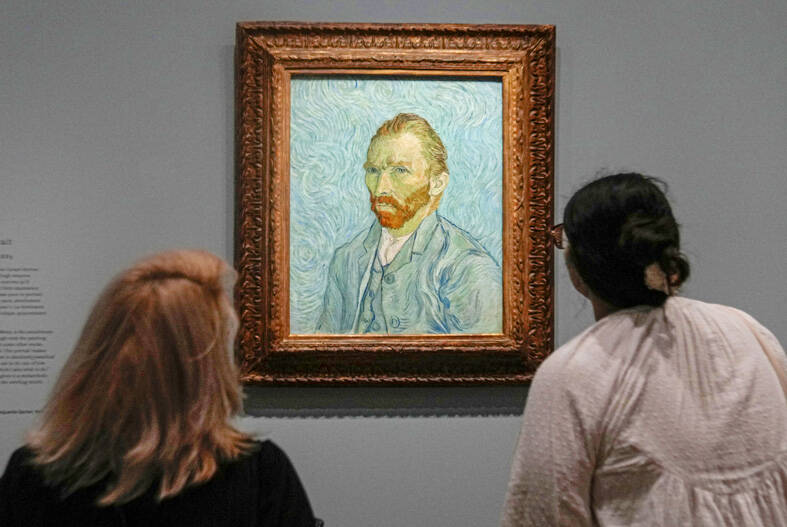AI Vincent Van Gogh is patient but unimpressed by yet another question about his chopped-off ear.
“I apologize for any confusion but it seems you are mistaken,” says the great painter’s avatar, in the sort of testy tone familiar to anyone who has toyed with AI language models. “I only cut off a small part of my ear lobe,” he insists (in fact, there are multiple accounts of how the artist mutilated his ear).
The artificial intelligence Van Gogh appears on a video screen at the end of a blockbuster exhibition at the Musee d’Orsay in Paris. The exhibition, running until February, is dedicated to the final weeks of his life in the village of Auvers-sur-Oise, just north of the French capital. Van Gogh shot himself with a rusty pistol in 1890 aged 37. It took him two days to die.

Photo: AP
But the AI Vincent is surprisingly well-versed in 21st century therapy-speak.
“While I did face mental health struggles, my move to Auvers-sur-Oise was not motivated by a desire to end my life,” he says.
As the 40 or so paintings at the Orsay exhibition make clear, his final weeks were extraordinarily prolific, full of masterpieces including The Church at Auvers, Wheatfield with Crows and his very last, Tree Roots.
All the more surprising is that this period has never been given a dedicated showcase, said Christophe Leribault, Musee d’Orsay president.
VIRTUAL VINCENT
Among the highlights is a room dedicated to his “double-square” panoramas, a technical revolution in which he used very long and thin canvases, prefiguring the wide-screen landscapes of cinema. It is perhaps fitting, then, that the show ends with modern technologies, which have become increasingly common as exhibitions try to pull in young audiences.
As well as the Van Gogh chatbot, visitors can also don a virtual reality headset to enter the kitchen of Dr Gachet, where Van Gogh spent time in his final weeks, take a surreal trip around an enormous version of his paint palette and plunge into the tree roots of his final painting. The state-of-the-art helmet from Taiwanese firm Vive Arts can track the hands of users — without the need for handheld controllers — allowing them to pick up items in the virtual world and play with globules of paint. The AI, by contrast, displays some of the teething problems of the nascent tech.
Asked about his favorite color, AI Vincent is very certain (yellow). But he struggles to recognize people in his life, failing to pick up the name of Dr Gachet when asked by a French journalist.
“It recognizes words in the French language but we still need to fine-tune the AI so that it understands proper nouns better,” said Christophe Renaudineau, head of Jumbo Mana, the Strasbourg start-up which designed the machine.
“This experiment will allow us to improve the model,” he added.

May 26 to June 1 When the Qing Dynasty first took control over many parts of Taiwan in 1684, it roughly continued the Kingdom of Tungning’s administrative borders (see below), setting up one prefecture and three counties. The actual area of control covered today’s Chiayi, Tainan and Kaohsiung. The administrative center was in Taiwan Prefecture, in today’s Tainan. But as Han settlement expanded and due to rebellions and other international incidents, the administrative units became more complex. By the time Taiwan became a province of the Qing in 1887, there were three prefectures, eleven counties, three subprefectures and one directly-administered prefecture, with

Taiwan Power Co (Taipower, 台電) and the New Taipei City Government in May last year agreed to allow the activation of a spent fuel storage facility for the Jinshan Nuclear Power Plant in Shihmen District (石門). The deal ended eleven years of legal wrangling. According to the Taipower announcement, the city government engaged in repeated delays, failing to approve water and soil conservation plans. Taipower said at the time that plans for another dry storage facility for the Guosheng Nuclear Power Plant in New Taipei City’s Wanli District (萬里) remained stuck in legal limbo. Later that year an agreement was reached

What does the Taiwan People’s Party (TPP) in the Huang Kuo-chang (黃國昌) era stand for? What sets it apart from their allies, the Chinese Nationalist Party (KMT)? With some shifts in tone and emphasis, the KMT’s stances have not changed significantly since the late 2000s and the era of former president Ma Ying-jeou (馬英九). The Democratic Progressive Party’s (DPP) current platform formed in the mid-2010s under the guidance of Tsai Ing-wen (蔡英文), and current President William Lai (賴清德) campaigned on continuity. Though their ideological stances may be a bit stale, they have the advantage of being broadly understood by the voters.

In a high-rise office building in Taipei’s government district, the primary agency for maintaining links to Thailand’s 108 Yunnan villages — which are home to a population of around 200,000 descendants of the Chinese Nationalist Party (KMT) armies stranded in Thailand following the Chinese Civil War — is the Overseas Community Affairs Council (OCAC). Established in China in 1926, the OCAC was born of a mandate to support Chinese education, culture and economic development in far flung Chinese diaspora communities, which, especially in southeast Asia, had underwritten the military insurgencies against the Qing Dynasty that led to the founding of